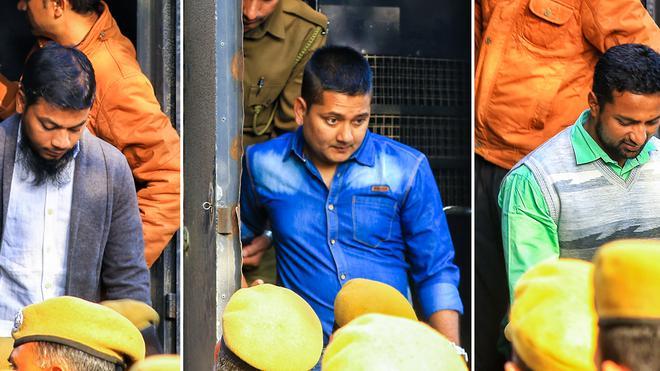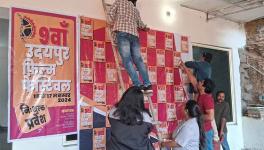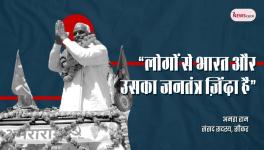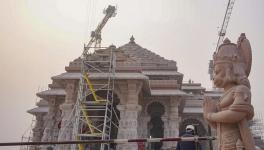2008 Jaipur Serial Blasts: Why Rajasthan ATS Case Against 4 Convicts Fell Flat in High Court

Image credit: PTI
New Delhi: Following the Rajasthan High Court’s March 29 judgment, acquitting four Muslim men in connection with the 2008 Jaipur serial blasts case, the Ashok Gehlot-led Congress government in the state has decided to challenge the acquittal in the Supreme Court. The government has also decided to terminate the services of the Additional Advocate General Rajesh Maharshi who “failed to effectively represent the case in the court”.
“It has been decided, following a high-level meeting, to appeal in the Supreme Court against the decision of the High Court’s decision in the Jaipur bomb blasts case. The best lawyers of the state government will continuously ensure justice to the victims,” Chief Minister Gehlot wrote on Twitter, “It has also been decided to terminate the services of the additional advocate general for failing to effectively represent the case in the court.”
The decision to file a special leave petition (SLP) in the apex court, challenging the acquittal, might be influenced by the opposition to the 132-page judgment not only by the Bharatiya Janata Party (BJP), but Gehlot’s arch rival within the Congress party, Sachin Pilot, as well.
Setting aside the conviction and death sentence awarded by the trial court in 2019 to the four for allegedly carrying out the blasts, the High Court proved beyond doubt that the men — Mohammed Salman, Saifur Rehman Ansari, Mohammed Saif and Mohammed Sarwar Azmi (all residents of Azamgarh in Uttar Pradesh) — were not involved in the crime that they were charged with.
Nine bombs strapped to bicycles had gone off at eight locations within a span of 25 minutes on May 13, 2008, in the Walled City of Jaipur, killing 71 people and injuring 185.
The court found “manipulations and fabrications in the material evidence” and observed the case is a “classic example of institutional failure resulting in botched/flawed/shoddy investigation”.
The division bench of justices Sameer Jain and Pankaj Bhandari stated the “investigation (into the case) was not fair” and “it appears that nefarious means were employed by the investigating agencies”.
“Material witnesses required to unfold the events were withheld and apparent manipulations and fabrications have been done during the investigation,” the court stated, “We fear this is not the first case to suffer due to failure of investigation agencies, and if things are allowed to continue the way they are, this certainly will not be the last case in which administration of justice is affected due to shoddy investigation”.
The bench ordered a probe against investigating officers and questioned the Anti-Terrorism Squad (ATS) for failing to provide credible evidence, holding them responsible for their “negligent, cursory and inefficient” actions.
The court observed that the investigating officers “lacked the required legal skills” and they approached the case in a “callous manner”.
“The failure on the part of the investigation agency has frustrated the case of the prosecution, and the evidence so recorded is not fulfilling the chain of evidence,” the judges said.
They said the special court relied upon inadmissible evidence and ignored material contradictions in the matter.
“...the learned trial court has erroneously relied upon inadmissible evidence, ignored material contradictions, and has also not properly considered the legal provisions enumerated in the Indian Evidence Act, 1872 (for short “Evidence Act”), the Information and Technology Act, 2000 and the Code of Criminal Procedure, 1973, which has led to the passing of the erroneous impugned order(s) which is against the settled position of law,” the bench noted.
THE PROSECUTION’S CASE
In each of the blast sites, the bombs were planted on “brand new” bicycles, which were placed at “carefully selected crowded market places near temples and police stations”. In total, eight FIRs were registered — four each at Police Station Kotwali and Police Station Manak Chowk.
On the next day of the incident i.e. May 14, 2008, two TV news channels — Aaj Tak and India — allegedly received an e-mail from banned terror outfit Indian Mujahideen (IM), claiming responsibility for the serial blasts.
Along with the e-mail, a video clip was also received, purportedly showing a bicycle with a bag placed on it. In the first part of the e-mail, there is a mention of the bicycle with frame no. 129489, which was placed near Police Station Kotwali at Chhoti Chaupad.
The bicycle with the same frame number was allegedly seized from the blast site near Police Station Kotwali in a damaged condition.
Exactly four months after the Jaipur blasts i.e. on September 13, 2008, there were serial bomb blasts at five places in Delhi.
On September 19, 2008, the Special Cell of the Delhi Police raided a building (L-18) at Batla House in Southeast Delhi’s Jamia Nagar locality — following an alleged tip-off that suspected terrorists allegedly involved in the Delhi serial bomb blasts were hiding there.
Two youngsters Mohammad Sajid and Aatif Ameen (both also from Azamgarh) were gunned down. One police officer, Inspector Mohan Chand Sharma, also lost his life in the operation in mysterious circumstances.
The police claimed to have arrested one Mohammad Saif from the flat. On October 2, 2008, Saif allegedly made a disclosure statement which was recorded by the Delhi Police. He allegedly admitted his “active” role in the Jaipur bomb blasts case and also named nine others and their “direct” involvement in planting the bombs at various places in the Pink City.
In the alleged disclosure statement, it was claimed that all these 10 accused had come in groups on May 11 to do reconnaissance of the places where they intended to plant bombs and returned on the same day by Ajmer Shatabdi train.
On May 12, they allegedly made bombs at Batla House; and on May 13, they all came to Bikaner House and boarded a Volvo Bus in different groups and returned on the same day in the evening by Ajmer Shatabdi in fake Hindu names.
The accused-appellants were allegedly identified by the persons who sold them the cycles, which were used by them to plant bombs at different places in Jaipur. Prosecution witness (PW) 117 Prakash Sain allegedly identified Mohammad Saif, PW -115 Laxman Jhajhani identified Sarwar Azmi, PW-123 Lalit Lakhwani identified Mohammad Saifur Rehman and PW-139 Rajesh Lakhwani identified Mohammad Salman.
After due investigation, a charge-sheet was filed. The trial court (a special court in Jaipur) framed charges under sections 120-B, 302, 307, 326, 324, 427, 121A, 124A, 153A of the Indian Penal Code (IPC), Section 3 of the Prevention of Damage to Public Property Act, 1984 read with Section 120-B IPC, sections 3, 4, 5, 6 of the Explosive Substances Act, 1908, sections 3/10, 13, 18, 20, 38 of the Unlawful Activities (Prevention) Act, 1967 or UAPA and Section 16(1)A of the UAPA read with Section 120-B of IPC.
The accused denied the charges and sought trial. A total of 156 witnesses were examined part from documents and articles. After hearing the two parties, the trial court convicted the four (Mohammad Salman, Mohammad Sarwar Azmi, Saifur Rehman and Mohammad Saif) and sentenced them to death. The fifth accused, Sahbaz Hussain, was acquitted. The State challenged the acquittal in the High Court.
The additional advocate general contended the “case rests on circumstantial evidence”. The first circumstance was that co-accused Saif had mentioned the names of the accused-appellants in his “disclosure statements” dated October 1-2, 2008.
Saif’s arrest by the Delhi Police on September 19, 2008, allegedly gave a breakthrough to the ATS in the investigation into the Jaipur serial blasts case. In his alleged disclosure statement, he reportedly named nine others, who were “involved in planting bombs” at various places.
Saif’s “disclosure statement” was later “corroborated” by the disclosure statement of accused-appellants Saifur Rehman, Sarwar Azmi and Salman under Section 10 of the Evidence Act.
The next circumstance against accused-appellants was the alleged disclosure statement made by them about the places where they planted bombs and memos of the place of purchase of cycles. It was argued that the ATS knew that the bombs were planted at 10 places. But nobody knew the place from where the accused-appellants purchased the cycle and planted the bombs. It was only within their exclusive knowledge.
By their own disclosure statements, the prosecution contended, accused-appellants have not only “admitted” their crime of planting bombs at different places, but they have also corroborated Saif’s “disclosure statement” and admitted the offence of hatching a “conspiracy” to carry out explosions in Jaipur.
The next circumstance against accused-appellants was Saif’s “disclosure statement” wherein he allegedly confessed that he along with his friend Azmi had purchased steel balls (pellets) to make bombs for the serial blasts from a cycle market near Delhi’s Jama Masjid.
The steel balls were allegedly purchased in the name of one Rahul Sharma with the purpose of using it in a science project.
PW149 Sanjeev Kumar deposed that Saif took them to a cycle shop (No. 555), Prem and Company, Delhi, where the shop owner, Subash Chand, informed them that Saif purchased the steel balls in the name of Rahul Sharma.
The next circumstance against the accused-appellants was their identification by persons who allegedly sold them the cycles which were used by them to plant bombs.
Another circumstance against accused-appellants was that after allegedly planting and exploding bombs in Jaipur, they returned to Delhi through Ajmer Shatabdi under fake Hindu names — Harsh Yadav, Rajhans, Ajay Singh and Jitendra Singh. The prosecution produced the reservation chart of coach no. C-3 to establish the allegation.
The government counsel argued the circumstances cited above cumulatively form a chain so complete and unerringly pointing towards the active role of accused-appellants in planting bombs on cycles at different places.
He contended the cumulative effect of the circumstances further gives rise to a “conclusive and irresistible inference of involvement of accused-appellants in the conspiracy with other co-accused".
The prosecution further argued that it cannot be a coincidence that four persons came to Jaipur from Delhi along with four others under fake names; that these persons purchased cycles from Kishan Pole Bazar from different shops under the same fake names; that after planting bombs, these persons left for Delhi by Ajmer Shatabdi train again under the same fake names.
With regard to Shahbaz Hussain, it was argued that he was the one who sent the e-mail to India TV and Aaj Tak on May 14, 2008. Thus, he was aware of the blasts and was one of the conspirators; hence, the order vide which he had been acquitted needed to be set aside and he should also be convicted and sentenced to the death penalty.
HOW THE CASE FELL FLAT
Little to nothing was done by the investigation agencies in the Jaipur case for four months till the similar serial blasts in Delhi.
The Special Cell of Delhi Police, on an alleged tip-off, raided a building (L-18) at Batla House in southeast Delhi’s Jamia Nagar on September 19, 2008, where the alleged perpetrators of the crime were holed up. The investigation into the Jaipur serial blasts case actually begin only after one of the accused, Mohammad Saif, the suspected lone survivor of the Batla House encounter, was allegedly apprehended and his statements were recorded under police custody.
The prosecution attempted to disguise the alleged statements made by the accused under police custody as “disclosure statements”. However, the said statements were not confessions or admission of guilt, as the same were recorded in police custody and are hit by the provisions of Section 162 Code Of Criminal Procedure (Cr. P.C.) read with sections 25, 26 and 27 of the Evidence Act, 1872.
Further, the same was not corroborated by the recovered evidence and material — making it unreliable and inadmissible. The prosecution ought to have recorded the statement under Section 164 Cr.P.C.
The alleged travel made by the accused/convicts between Delhi and Jaipur was not conclusively proved. No CCTV footage and no call details were produced from the seized mobile from the accused in order to support the alleged travel made on May 11, 2008 or May 13, 2008.
The e-mail allegedly sent by the accused, claiming responsibility for the blasts, to the media houses and to the then Rajasthan ADG AK Jain on May 14, 2008, was neither supported by the mandatory certificate as required under Section 65B of the Evidence Act nor was it corroborated by the statements of Jain, Prakash Tandon or others from the media houses who received the alleged e-mail.
“In absence of mandatory certificate and corroborative statements of Mr A.K. Jain, Mr Prakash Tandon or other people from the media houses, the e-mail relied upon by the prosecution is also an inadmissible piece of evidence,” the court ruled.
As per the prosecution’s case, the accused/convicts allegedly sent the e-mail from ‘Naveen Café’, owned by one Madhukar Mishra — a resident of Sahibabad in Uttar Pradesh. However, the sending of the e-mail from Sahibabad was not established. The original CPU on which CD was written was not seized by the police.
The site plan prepared was also not reflecting the existence of the relevant CPU system. The prosecution told the court Mishra was not present when the investigating officers visited the cafe to make seizure and record his statements. He was made to talk to the officials with the help of a cell phone of one of his relatives. The officials did not even attempt to talk to him directly with their own cell phones. All cast a shadow of doubt.
The register, recording entry and exit of customers, was also not seized by the police.
The investigating agency failed to impound/seize, at the initial stage of the investigation, the relevant bill books from the bicycle vendors who allegedly sold the bicycles, which were used in the explosions, to the accused/convicts. The bill books were a substantial piece of evidence and could have been relied upon under Section 34 of the Evidence Act.
Further, Dinesh Mahawar, a mechanic at Anju Cycle Shop who assembled the bicycles, was also not examined. Also, the invoices and the bill books that were produced before the court were tampered with. It made the evidence weak.
There was no scientific evidence examining or comparing the ball bearings seized from the site of the blasts to that seized from the shop of Subhash Chandra. There was a mismatch in the size of ball bearings, which were seized from the Delhi shop and which were recovered from the explosion site. It created doubt, and there was no further investigation by the prosecution to clear it.
The test identification parade (TIP) was also vitiated for non-compliance with the Rajasthan Police Manual and Rules. The court found a violation of Clause 7.31 as the TIP was conducted in the presence of the investigating officer, which was apparent from the statements made in the cross-examination by one Bhanwar Singh and Satyendra Singh Ranawat as also by the prosecution witnesses Laxman Jajhani, Prakash Sain and Lalit Lakhwani.
The jail registrar also established that the investigating officer was present along with the witnesses in jail. The non-compliance with necessary provisions for conducting the TIP was overlooked and it vitiated the entire procedure.
Further, the TIP was also conducted after a lapse of a substantial period of time and it is likely that the witness may have forgotten the features of the accused and thus it was very likely that mistakes might have been committed.
The prosecution also failed to produce/examine some of the key witnesses. The most crucial of them was the examination of Rajendra Singh Nain, who allegedly first visited cycle shops and collected copies of the receipts, etc.
Other important witnesses who were not examined included Jain, Tandon or other people from the media houses who allegedly received the e-mail, Dinesh Mahawar, the mechanic who allegedly assembled the bicycle, and the handwriting expert on whose opinion reliance was placed by the prosecution.
The above-mentioned facts led the court to conclude, “Having regard to the totality of circumstances and the evidence on record, it is difficult to hold that the prosecution had proved the guilt of the accused by adducing cogent and clinching evidence. As per the settled legal position, in order to sustain a conviction, the circumstances taken cumulatively should form a chain so complete that there is no escape from the conclusion that within all human probability, the crime was committed by the accused only and no one else.”
The judges said the circumstantial evidence must be complete and incapable of explanation of any other hypothesis than that of the guilt of the accused and such evidence should not only be consistent with the guilt of the accused but should be inconsistent with his innocence.
“The prosecution has to bring home the charges levelled against the accused beyond a reasonable doubt,” said the court, adding that the prosecution failed to do so; resultantly, the Court is left with no alternative but to acquit the accused.
“It may be true that if accused in a heinous crime go unpunished or are acquitted, a kind of agony and frustration may be caused to the society in general and to the family of the victims in particular; however, the law does not permit the courts to punish the accused on the basis of moral conviction or on suspicion alone. No conviction should be based merely on the apprehension of indictment or condemnation over the decision rendered,” read the order.
The Association for Protection of Civil Rights (APCR), which represented the exonerates, welcomed the verdict, adding that the men were falsely implicated in the case.
“This was the first case where the death penalty had been awarded on circumstantial evidence,” said Farooq Paker, former president of the Rajasthan chapter of the APCR. “There was no direct evidence. Not a single witness could identify any of these four men planting a bomb on the bicycle. Also, the bicycle purchase bill produced in court is different from the frame number of the bicycle used in the bomb blast,” he added.
Advocate Syed Sadat Ali, who was part of the legal defence team for the four men, told NewsClick that the ATS theory had plenty of loopholes with glaring lapses in investigation. “The earlier judgment of the trial court was a perfect example of the institutional failure of administering justice,” he said.
“We are thankful to the honourable High Court of Rajasthan for breathing new hopes into the judicial system through this acquittal order,” he added.
Get the latest reports & analysis with people's perspective on Protests, movements & deep analytical videos, discussions of the current affairs in your Telegram app. Subscribe to NewsClick's Telegram channel & get Real-Time updates on stories, as they get published on our website.
























